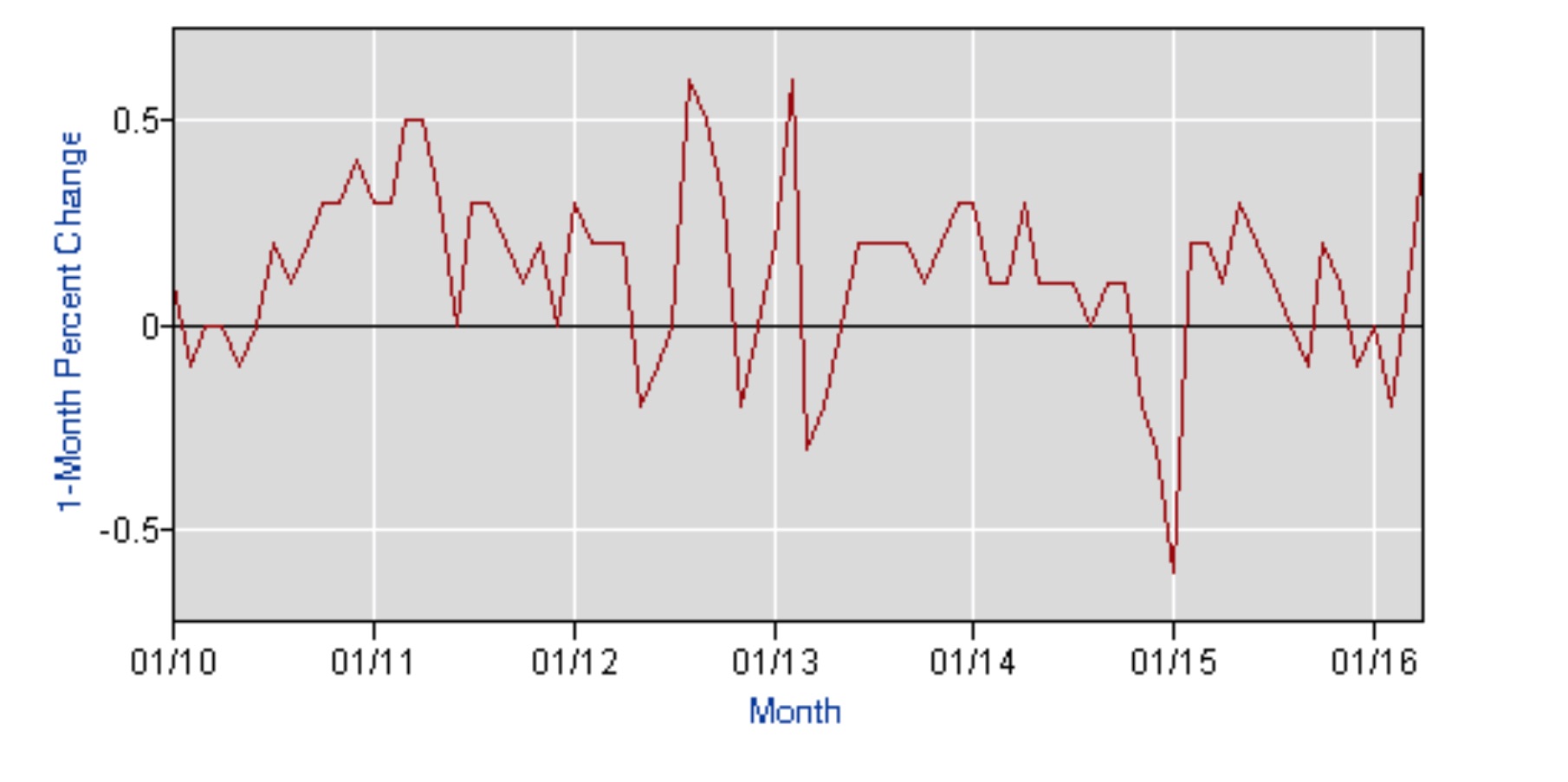Headline inflation, measured by the Consumer Price Index for All Urban Consumers (CPI-U), was 0.5% in April according to today’s report from the US Bureau of Labor Statistics. With seasonal adjustments, prices were up 0.4%, the highest monthly rate since February 2013 and slightly above what markets had expected. A Bloomberg survey of economists showed a large range in inflation expectations for April, from 0.2% to 0.7%.
Overall, price levels were 1.1% higher for the year ending in April compared to 0.9% for the year ending in March. While annual inflation remains significantly below the Fed’s 2% target, core measurements suggest the US economy is slowly strengthening. Core annual inflation was 2.1% in April and 2.2% in March.
April’s Inflation
Inflation was broad based in April as the food and energy indexes both increased, as did the index for all items less food and energy. Prices at the pump were the main contributor to monthly inflation, up 8.1% with seasonal adjustments and 9.1% without adjustments. The energy index, which accounts for approximately 6.6% of the CPI-U and includes gasoline, climbed 3.4% in April.
Seasonally Adjusted Monthly % Change in CPI-U by Category (2016)
| January | February | March | April | May | June | July | |
|---|---|---|---|---|---|---|---|
| All Items | 0 | -0.2 | 0.1 | 0.4 | 0.2 | 0.2 | 0.0 |
| Food | 0 | 0.2 | -0.2 | 0.2 | -0.2 | -0.1 | 0.0 |
| Energy | -2.8 | -6.0 | 0.9 | 3.4 | 1.2 | 1.3 | -1.6 |
| Gasoline | -4.8 | -12.5 | 2.2 | 8.1 | 2.3 | 3.3 | -4.7 |
| Fuel Oil (non seasonally adjusted) | -6.5 | -2.9 | 1.7 | 1.9 | 6.2 | 3.7 | -1.5 |
| Electricity | -0.7 | -0.2 | 0.4 | -0.3 | -0.2 | -0.5 | 0.5 |
| Utilities (piped gas service) | -0.6 | 1.0 | -0.7 | 0.6 | 1.7 | -0.4 | 3.1 |
| Energy Services | -0.7 | 0.1 | 0.2 | -0.1 | 0.2 | -0.5 | 1.0 |
| All Items Less Food and Energy | 0.3 | 0.3 | 0.1 | 0.2 | 0.2 | 0.2 | 0.1 |
| Services Less Energy Services | 0.3 | 0.3 | 0.2 | 0.3 | 0.4 | 0.3 | 0.2 |
| Shelter | 0.3 | 0.3 | 0.2 | 0.3 | 0.4 | 0.3 | 0.2 |
| Transportation Services | 0.4 | 0.2 | 0.2 | 0.7 | 0.3 | 0.3 | -0.2 |
| Medical Care Services | 0.5 | 0.5 | 0.1 | 0.3 | 0.5 | 0.2 | 0.5 |
The price of food was up 0.2% in April following a decline of that amount in March. The index for food at home increased 0.1% while the index for food away from home was up 0.2%. Within the food index, the most notable changes in April include; the price of eggs, down 6.3% and the price of tomatoes, down 4.7%. The index for fruits and vegetables also slipped 0.5% on a seasonally adjusted basis in April after declining 1.9% in March.
The index for all items less food and energy was up 0.2% in April after increasing 0.1% in March. This measure of core inflation eliminates items with highly volatile prices and is a good indicator of underlying price trends. According the current composition of the CPI, the index for all items less food and energy represents about 79.5% of overall consumer spending.
Within the core index, prices in April were 0.4% lower for household furnishings and supplies and 0.3% lower for apparel. Over the same period, the price of medical care commodities grew 0.4%, with prescription drug prices up 0.7% and nonprescription drug prices up 0.4%. The index for medical care services was 0.3% higher as the price of visiting dentists and eye doctors both increased by 0.7% in April. The cost of health insurance was 0.4% higher, following an increase of the same amount in March.
The index for transportation services, which is included in the core index, posted a seasonally adjusted inflation rate of 0.7%. This was largely driven by a 1.2% spike in the cost of motor vehicle insurance, although prices were higher across the board within transpiration services. The indexes for new and used vehicles, which are not included in transportation services but are part of the core index, both fell by 0.3% in April.
12-Month Inflation
The CPI-U grew 1.1% for the year ending in April despite a 8.9% decline in energy prices. For the year, the price of fuel oil declined 27.5%, and gas prices were 13.8% lower. The index for energy commodities dropped 14.2% compared to the index for energy services, which was only down 3.1% year over year.
Overall, food prices were up 0.9% over the 12 months ending in April. However, the price of food at home declined 0.3% while the price of food away from home increased by 2.7%.
The index for all items less food and energy gained 2.1% for the year. Within this index, commodities (commodities less food and energy commodities) declined 0.5%. Over the same year, the price of services (services less energy services) increased by 3.0%.
Inflation by Region
Inflation was distributed equitably across geographical regions in April. Prices grew marginally more in the Northeast, up 0.6% compared to the midwest, south and west (up 0.5%, 0.4% and 0.4% respectively). However, for the year ending in April, the western states recorded significantly higher inflation than the rest of the US, 1.8% compared a national average inflation rate of 1.1%.
Inflation was also stronger in bigger cities over the year ending in April. The average inflation rate for cities with populations over 1.5 million was 1.4% compared to 0.7% for cities with populations between 50,000 and 1.5 million. Large west coast cities were a major contributor to inflation over the past year. San Francisco, Seattle and Los Angeles recorded respective inflation rates of 2.7%, 2.5% and 2.0% – all well above the national average.
| Urban Population | 12-month | August |
|---|---|---|
| over 1.5 million | 1.3% | 0.1% |
| 50,000 to 1.5 million | 0.7% | 0.1% |
| under 50,000 | 0.8% | -0.1% |
| Urban Regions | 12-month | August |
|---|---|---|
| Northeast | 1.1% | 0.1% |
| Midwest | 0.6% | 0.1% |
| South | 1.0% | 0.1% |
| West | 1.6% | 0.1% |
Outlook
Today’s inflation report suggests the economy is moving in the right direction and increases the likelihood of rate hikes in the near future. Prior to today’s report, rate hikes had not been anticipated until at least December. However, there has been a lack of consensus among members the Fed regarding the current state of the US economy and the risks posed by turmoil in global markets. Today’s report suggests that the domestic economy is moving forward and tightening or raising rates to reign in growth and prevent bubbles, may be prudent. The Fed meets next on June 14th and 15th and there will likely be more agreement regarding the need to increase interest rates.





